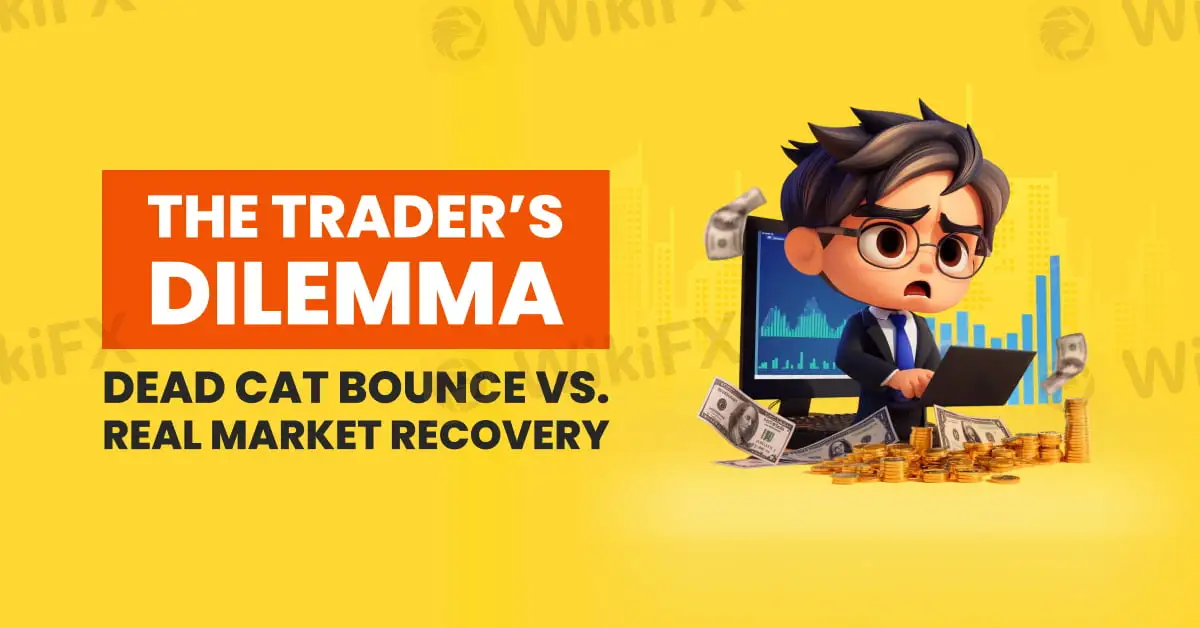简体中文
繁體中文
English
Pусский
日本語
ภาษาไทย
Tiếng Việt
Bahasa Indonesia
Español
हिन्दी
Filippiiniläinen
Français
Deutsch
Português
Türkçe
한국어
العربية
The Trader’s Dilemma: Dead Cat Bounce vs. Genuine Recovery
Abstract:One of the biggest challenges in trading is knowing whether a market is making a real comeback, or just fooling you. Many traders fall into the trap of thinking a falling stock or index has turned around, only to watch it fall again. How frustrating!

One of the biggest challenges in trading is knowing whether a market is making a real comeback, or just fooling you. Many traders fall into the trap of thinking a falling stock or index has turned around, only to watch it fall again. This short-lived rise is whats known as a dead cat bounce.
The term might sound strange, but it describes a common situation: after a big drop, prices suddenly go up for a short time, giving the impression that things are improving. But then they fall again, continuing the downtrend. On the other hand, a real reversal is when the market truly changes direction and starts a new trend (either up or down) for a longer period.

- Check the Trading Volume
Volume simply means how many people are buying and selling. If prices bounce back but not many people are trading, that move might not be strong. A real reversal usually comes with high volume, which is a sign that big players (like institutions) are stepping in with confidence.
- Look at the Bigger Picture
Dont just focus on one bounce. Step back and look at how the price has moved over time. If the price fails to move past a key level (like an old support or resistance point), it could be just a short-lived bounce. A real trend change often forms clear patterns, like a double bottom (a “W” shape) or a steady climb over days or weeks.
- Use Momentum Indicators
Tools like the Relative Strength Index (RSI) or MACD (Moving Average Convergence Divergence) can help show if momentum is building or fading. If the price is falling but these indicators are starting to rise, that might be a clue that the downtrend is losing steam, and a real reversal could be coming.
- Is There a Reason Behind the Move?
Always ask: Why is the price moving? A true reversal is often linked to big news, like strong earnings, a change in interest rates, or a major shift in market sentiment. A bounce without any clear reason might just be noise.
- Give It Time
This might be the hardest part, which is waiting. Real reversals take time to confirm. If you're too quick to jump in, you might get caught in a false move. It's often safer to wait for the price to break important levels (like moving averages) before acting.
Markets can be unpredictable. While learning to spot real reversals can make you a better trader, remember that no tool or signal is perfect.
Risk management should always come first. Never trade more than you can afford to lose, and always use stop-losses to protect yourself. Studying charts, news, and patterns can improve your chances, but every market move is different. What worked yesterday might not work tomorrow.
In trading, protecting your capital is the most important rule. Stay sharp, stay informed, and never stop learning.

Disclaimer:
The views in this article only represent the author's personal views, and do not constitute investment advice on this platform. This platform does not guarantee the accuracy, completeness and timeliness of the information in the article, and will not be liable for any loss caused by the use of or reliance on the information in the article.
Read more

FortuixAgent Review 2025: Is it Scam or Legit?
Is FortuixAgent a trustworthy trading platform or just another scam in disguise? In this 2025 review, we investigate FortuixAgent’s background, licensing claims, features, user experiences, and red flags to help you make an informed decision.

No Regulation, Revoked Licence: Is Tradehall Safe to Use?
In the fast-growing world of online trading, safety and regulation must always come first. Traders need to choose brokers that are properly licensed and follow the rules. Sadly, not all brokers meet these standards, and Tradehall is a clear example of this.

Retirement Dreams Shattered: Don't Do This To Yourself!
Two retired Malaysian men have collectively lost more than RM1.14 million to fraudulent investment schemes promoted on social media platforms.

ZFX: A Closer Look at Its Licences
In an industry where safety and transparency are essential, the regulatory status of online brokers has never been more important. For traders seeking to protect their capital, ensuring that a platform operates under recognised and stringent oversight can make all the difference. Keep reading to learn more about ZFX and its licenses.
WikiFX Broker
Latest News
Inside MBI: The Billion-Dollar Ponzi Scheme That Shook Malaysia
ZFX: A Closer Look at Its Licences
Should you buy or sell US dollars in the next three to six months?
Tradehall Broker Review 2025: Read Before Trade
XM Rolls Out New Forex Trading Competition Platform for 2025
Tether Freezes $12.3 Million in USDT Over Money Laundering Concerns
MiCA Unlocks EU Crypto Market, but National Tensions Rise as Gemini and Coinbase Near Approval
Retirement Dreams Shattered: Don't Do This To Yourself!
Philippines Sets Southeast Asia’s First Crypto Regulatory Framework
EU Regulators Imposed Over €71M in Sanctions in 2024, ESMA Calls for Enforcement Convergence
Currency Calculator


